Threshold Soil Moisture Levels Influence Soil CO2 Emissions: A Machine Learning Approach to Predict Short-Term Soil CO2 Emissions from Climate-Smart Fields
Abstract
1. Introduction
2. Materials and Methods
2.1. Study Site and Experimental Design
2.2. Irrigation Management
2.3. Soil Moisture Monitoring
2.4. Soil CO2 Flux Measurement
2.5. Statistical Analysis
2.6. Trend Analysis
2.7. Classification and Regression Tree
- (1)
- Selection of the response variable (soil CO2 emission) and the input variable (soil moisture) for each organically amended plot.
- (2)
- Partitioning the input variable space X1, X2,…, Xp into J discrete and non-intersecting regions, denoted as R1, R2,…, RJ.
- (3)
2.8. Multilinear Regression
2.9. Generalized Additive Models (GAMs)
2.10. Model Performance Evaluation
3. Results and Discussion
3.1. Impact of Soil Amendments on CO2 Emissions
3.2. Short-Term Trends in Soil CO2 Emissions
3.3. Effects of Soil Moisture and Thresholds on CO2 Emissions
3.4. Potential Impact of Weather Variables on Soil CO2 Emissions
3.5. Predicting Soil CO2 Emissions Using Weather Variables and Soil Moisture
3.6. Potentials and Limitations
4. Conclusions
- (a)
- The Level II rate of biochar (B2X) reduced soil CO2 emissions by 14.5% compared to the control plots. The maximum soil CO2 emissions were observed from the double recommended chicken manure and the Level II biochar (C2XB2X) plots, indicating that mixing biochar with chicken manure failed to reduce soil CO2 emissions. Also, mixing biochar with dairy/chicken manure showed a decreasing trend of CO2 emissions over time. For example, C2XB2X showed a tau value of −0.48 in the Mann–Kendall trend analysis.
- (b)
- The presence of soil organic amendments enhanced nutrient availability and plant growth, leading to increased crop water demand. As a result, the plants in the organically amended plots might have consumed more water, contributing to more efficient resource use but also reducing the soil moisture content compared to the control fields.
- (c)
- The soil moisture levels significantly correlated with soil CO2 emissions from most organically amended plots. The highest correlation was observed for double-recommended chicken and the Level I biochar plots (C2XBX). The decision tree approach applied in this study quantified critical thresholds of soil moisture corresponding to soil CO2 emissions. In the case of C2XBX, the soil moisture threshold identified was 0.133 m3m−3, indicating that soil moisture higher than 0.133 m3m−3 leads to higher soil CO2 emissions from C2XBX plots. In predicting soil CO2, GAMs outperformed MLR across all organic amendment types and rates.
Supplementary Materials
Author Contributions
Funding
Institutional Review Board Statement
Informed Consent Statement
Data Availability Statement
Acknowledgments
Conflicts of Interest
References
- Shahzad, A.; Ullah, S.; Dar, A.A.; Sardar, M.F.; Mehmood, T.; Tufail, M.A.; Shakoor, A.; Haris, M. Nexus on Climate Change: Agriculture and Possible Solution to Cope Future Climate Change Stresses. Environ. Sci. Pollut. Res. 2021, 28, 14211–14232. [Google Scholar] [CrossRef] [PubMed]
- Lipper, L.; Thornton, P.; Campbell, B.M.; Baedeker, T.; Braimoh, A.; Bwalya, M.; Caron, P.; Cattaneo, A.; Garrity, D.; Henry, K.; et al. Climate-Smart Agriculture for Food Security. Nat. Clim. Chang. 2014, 4, 1068–1072. [Google Scholar] [CrossRef]
- Lobell, D.B.; Schlenker, W.; Costa-Roberts, J. Climate Trends and Global Crop Production since 1980. Science 2011, 333, 616–620. [Google Scholar] [CrossRef] [PubMed]
- Battisti, D.S.; Naylor, R.L. Historical Warnings of Future Food Insecurity with Unprecedented Seasonal Heat. Science 2009, 323, 240–244. [Google Scholar] [CrossRef]
- Smith, P.; Bustamante, M.; Ahammad, H.; Clark, H.; Dong, H.; Elsiddig, E.A.; Haberl, H.; Harper, R.; House, J.; Jafari, M. Agriculture, Forestry and Other Land Use (AFOLU). In Climate Change 2014: Mitigation of Climate Change. Contribution of Working Group III to the Fifth Assessment Report of the Intergovernmental Panel on Climate Change; Cambridge University Press: Cambridge, UK, 2014; pp. 811–922. [Google Scholar]
- Wollenberg, E.; Richards, M.; Smith, P.; Havlík, P.; Obersteiner, M.; Tubiello, F.N.; Herold, M.; Gerber, P.; Carter, S.; Reisinger, A.; et al. Reducing Emissions from Agriculture to Meet the 2 °C Target. Glob. Change Biol. 2016, 22, 3859–3864. [Google Scholar] [CrossRef]
- Solazzo, E.; Galmarini, S. Error Apportionment for Atmospheric Chemistry-Transport Models—A New Approach to Model Evaluation. Atmos. Chem. Phys. 2016, 16, 6263–6283. [Google Scholar] [CrossRef]
- FAO. “Climate-Smart” Agriculture: Policies, Practices and Financing for Food Security, Adaption and Mitigation; Food and Agriculture Organization of the United Nations: Rome, Italy, 2010; ISBN 9251011745. [Google Scholar]
- NASS. 2022 Census of Agriculture; NASS: Beijing, China, 2022.
- Fares, A.; Bensley, A.; Bayabil, H.; Awal, R.; Fares, S.; Valenzuela, H.; Abbas, F. Carbon Dioxide Emission in Relation with Irrigation and Organic Amendments from a Sweet Corn Field. J. Environ. Sci. Health Part B 2017, 52, 387–394. [Google Scholar] [CrossRef]
- Veettil, A.V.; Rahman, A.; Awal, R.; Fares, A.; Melaku, N.D.; Thapa, B.; Elhassan, A.; Woldesenbet, S. Transforming Soil: Climate-Smart Amendments Boost Soil Physical and Hydrological Properties. Soil Syst. 2024, 8, 134. [Google Scholar] [CrossRef]
- Imran, M.A.; Ali, A.; Culas, R.J.; Ashfaq, M.; Baig, I.A.; Nasir, S.; Hashmi, A.H. Sustainability and efficiency analysis wrt adoption of climate-smart agriculture (CSA) in Pakistan: A group-wise comparison of adopters and conventional farmers. Environ. Sci. Pollut. Res. 2022, 29, 19337–19351. [Google Scholar] [CrossRef]
- Fares, A.; Abbas, F.; Ahmad, A.; Deenik, J.L.; Safeeq, M. Response of Selected Soil Physical and Hydrologic Properties to Manure Amendment Rates, Levels, Andtypes. Soil Sci. 2008, 173, 522–533. [Google Scholar] [CrossRef]
- Chadwick, D.; Sommer, S.; Thorman, R.; Fangueiro, D.; Cardenas, L.; Amon, B.; Misselbrook, T. Manure Management: Implications for Greenhouse Gas Emissions. Anim. Feed Sci. Technol. 2011, 166–167, 514–531. [Google Scholar] [CrossRef]
- Liu, X.; Wang, S.; Zhuang, Q.; Jin, X.; Bian, Z.; Zhou, M.; Meng, Z.; Han, C.; Guo, X.; Jin, W.; et al. A review on carbon source and sink in arable land ecosystems. Land 2022, 11, 580. [Google Scholar] [CrossRef]
- Hamrani, A.; Akbarzadeh, A.; Madramootoo, C.A. Machine Learning for Predicting Greenhouse Gas Emissions from Agricultural Soils. Sci. Total Environ. 2020, 741, 140338. [Google Scholar] [CrossRef] [PubMed]
- González Costa, J.J.; Reigosa, M.J.; Matías, J.M.; Covelo, E.F. Soil Cd, Cr, Cu, Ni, Pb and Zn Sorption and Retention Models Using SVM: Variable Selection and Competitive Model. Sci. Total Environ. 2017, 593–594, 508–522. [Google Scholar] [CrossRef]
- Pham, B.T.; Nguyen, M.D.; Van Dao, D.; Prakash, I.; Ly, H.B.; Le, T.T.; Ho, L.S.; Nguyen, K.T.; Ngo, T.Q.; Hoang, V.; et al. Development of Artificial Intelligence Models for the Prediction of Compression Coefficient of Soil: An Application of Monte Carlo Sensitivity Analysis. Sci. Total Environ. 2019, 679, 172–184. [Google Scholar] [CrossRef]
- Schaufler, G.; Kitzler, B.; Schindlbacher, A.; Skiba, U.; Sutton, M.A.; Zechmeister-Boltenstern, S. Greenhouse Gas Emissions from European Soils under Different Land Use: Effects of Soil Moisture and Temperature. Eur. J. Soil Sci. 2010, 61, 683–696. [Google Scholar] [CrossRef]
- Zhang, Y.; Hou, W.; Chi, M.; Sun, Y.; An, J.; Yu, N.; Zou, H. Simulating the Effects of Soil Temperature and Soil Moisture on CO2 and CH4 Emissions in Rice Straw-Enriched Paddy Soil. CATENA 2020, 194, 104677. [Google Scholar] [CrossRef]
- Keiluweit, M.; Wanzek, T.; Kleber, M.; Nico, P.; Fendorf, S. Anaerobic Microsites Have an Unaccounted Role in Soil Carbon Stabilization. Nat. Commun. 2017, 8, 1771. [Google Scholar] [CrossRef]
- Batson, J.; Noe, G.B.; Hupp, C.R.; Krauss, K.W.; Rybicki, N.B.; Schenk, E.R. Soil Greenhouse Gas Emissions and Carbon Budgeting in a Short-Hydroperiod Floodplain Wetland. J. Geophys. Res. Biogeosci. 2015, 120, 77–95. [Google Scholar] [CrossRef]
- Tanha, M.; Mohtar, R.H.; Assi, A.T.; Awal, R.; Fares, A. Soil Hydrostructural Parameters under Various Soil Management Practices. Agric. Water Manag. 2024, 292, 108633. [Google Scholar] [CrossRef]
- Awal, R.; Fares, A.; Habibi, H. Irrigation Scheduling Tools: IrrigWise and IrrigWise-PRISM for Agricultural Crops and Urban Landscapes. In Proceedings of the 6th Decennial National Irrigation Symposium, San Diego, CA, USA, 6–8 December 2021. [Google Scholar] [CrossRef]
- Mittelbach, H.; Lehner, I.; Seneviratne, S.I. Comparison of Four Soil Moisture Sensor Types under Field Conditions in Switzerland. J. Hydrol. 2012, 430–431, 39–49. [Google Scholar] [CrossRef]
- Spelman, D.; Kinzli, K.-D.; Kunberger, T. Calibration of the 10HS Soil Moisture Sensor for Southwest Florida Agricultural Soils. J. Irrig. Drain. Eng. 2013, 139, 965–971. [Google Scholar] [CrossRef]
- Mann, H.B. Nonparametric Tests Against Trend. Econometrica 1945, 13, 245–249. [Google Scholar] [CrossRef]
- Bzdok, D.; Krzywinski, M.; Altman, N. Machine Learning: A Primer. Nat. Methods 2017, 14, 1119–1120. [Google Scholar] [CrossRef]
- James, G.; Witten, D.; Hastie, T.; Tibshirani, R. An Introduction to Statistical Learning; Springer: Berlin/Heidelberg, Germany, 2013; Volume 112. [Google Scholar]
- Pekel, E. Estimation of soil moisture using decision tree regression. Theor. Appl. Climatol. 2020, 139, 1111–1119. [Google Scholar] [CrossRef]
- Hothorn, T.; Hornik, K.; Strobl, C.; Zeileis, A. Party: A Laboratory for Recursive Partytioning. 2010. Available online: https://cran.r-project.org/web/packages/party/vignettes/party.pdf (accessed on 30 June 2025).
- Guo, M.; He, Z.; Uchimiya, S.M. Introduction to Biochar as an Agricultural and Environmental Amendment. In Agricultural and Environmental Applications of Biochar: Advances and Barriers; Soil Science Society of America, Inc.: Madison, WI, USA, 2015; pp. 1–14. [Google Scholar] [CrossRef]
- Gascó, G.; Paz-Ferreiro, J.; Cely, P.; Plaza, C.; Méndez, A. Influence of Pig Manure and Its Biochar on Soil CO2 Emissions and Soil Enzymes. Ecol. Eng. 2016, 95, 19–24. [Google Scholar] [CrossRef]
- Sohi, S.P.; Krull, E.; Lopez-Capel, E.; Bol, R. A Review of Biochar and Its Use and Function in Soil. Adv. Agron. 2010, 105, 47–82. [Google Scholar] [CrossRef]
- Lehmann, J.; Cowie, A.; Masiello, C.A.; Kammann, C.; Woolf, D.; Amonette, J.E.; Cayuela, M.L.; Camps-Arbestain, M.; Whitman, T. Biochar in Climate Change Mitigation. Nat. Geosci. 2021, 14, 883–892. [Google Scholar] [CrossRef]
- Jeffery, S.; Abalos, D.; Prodana, M.; Bastos, A.C.; Van Groenigen, J.W.; Hungate, B.A.; Verheijen, F. Biochar Boosts Tropical but Not Temperate Crop Yields. Environ. Res. Lett. 2017, 12, 053001. [Google Scholar] [CrossRef]
- Luo, L.; Wang, J.; Lv, J.; Liu, Z.; Sun, T.; Yang, Y.; Zhu, Y.G. Carbon Sequestration Strategies in Soil Using Biochar: Advances, Challenges, and Opportunities. Environ. Sci. Technol. 2023, 57, 11357–11372. [Google Scholar] [CrossRef]
- Lorenz, K.; Lal, R. Biochar Application to Soil for Climate Change Mitigation by Soil Organic Carbon Sequestration. J. Plant Nutr. Soil Sci. 2014, 177, 651–670. [Google Scholar] [CrossRef]
- Zheng, X.; Xu, W.; Dong, J.; Yang, T.; Shangguan, Z.; Qu, J.; Li, X.; Tan, X. The Effects of Biochar and Its Applications in the Microbial Remediation of Contaminated Soil: A Review. J. Hazard. Mater. 2022, 438, 129557. [Google Scholar] [CrossRef] [PubMed]
- Cross, A.; Sohi, S.P. A Method for Screening the Relative Long-Term Stability of Biochar. GCB Bioenergy 2013, 5, 215–220. [Google Scholar] [CrossRef]
- Sistani, K.R.; Simmons, J.R.; Jn-Baptiste, M.; Novak, J.M. Poultry Litter, Biochar, and Fertilizer Effect on Corn Yield, Nutrient Uptake, N2O and CO2 Emissions. Environments 2019, 6, 55. [Google Scholar] [CrossRef]
- Galvez, A.; Sinicco, T.; Cayuela, M.L.; Mingorance, M.D.; Fornasier, F.; Mondini, C. Short Term Effects of Bioenergy By-Products on Soil C and N Dynamics, Nutrient Availability and Biochemical Properties. Agric. Ecosyst. Environ. 2012, 160, 3–14. [Google Scholar] [CrossRef]
- Ameloot, N.; De Neve, S.; Jegajeevagan, K.; Yildiz, G.; Buchan, D.; Funkuin, Y.N.; Prins, W.; Bouckaert, L.; Sleutel, S. Short-Term CO2 and N2O Emissions and Microbial Properties of Biochar Amended Sandy Loam Soils. Soil Biol. Biochem. 2013, 57, 401–410. [Google Scholar] [CrossRef]
- Shahbaz, M.; Kuzyakov, Y.; Sanaullah, M.; Heitkamp, F.; Zelenev, V.; Kumar, A.; Blagodatskaya, E. Microbial Decomposition of Soil Organic Matter Is Mediated by Quality and Quantity of Crop Residues: Mechanisms and Thresholds. Biol. Fertil. Soils 2017, 53, 287–301. [Google Scholar] [CrossRef]
- Butler, T.J.; Muir, J.P. Dairy Manure Compost Improves Soil and Increases Tall Wheatgrass Yield. Agron. J. 2006, 98, 1090–1096. [Google Scholar] [CrossRef]
- Jannoura, R.; Joergensen, R.G.; Bruns, C. Organic Fertilizer Effects on Growth, Crop Yield, and Soil Microbial Biomass Indices in Sole and Intercropped Peas and Oats under Organic Farming Conditions. Eur. J. Agron. 2014, 52, 259–270. [Google Scholar] [CrossRef]
- Veettil, A.V.; Mishra, A.K. Quantifying Thresholds for Advancing Impact-Based Drought Assessment Using Classification and Regression Tree (CART) Models. J. Hydrol. 2023, 625, 129966. [Google Scholar] [CrossRef]
- Ren, W.; Banger, K.; Tao, B.; Yang, J.; Huang, Y.; Tian, H. Global Pattern and Change of Cropland Soil Organic Carbon during 1901–2010: Roles of Climate, Atmospheric Chemistry, Land Use and Management. Geogr. Sustain. 2020, 1, 59–69. [Google Scholar] [CrossRef]
- Bista, P.; Shakya, S.R.; Acharya, P.; Ghimire, R. Evaluating machine learning models for greenhouse gas emissions prediction in diversified semi-arid cropping systems. Soil Sci. Soc. Am. J. 2025, 89, e70057. [Google Scholar] [CrossRef]
- Abdalla, M.; Kumar, S.; Jones, M.; Burke, J.; Williams, M. Testing DNDC model for simulating soil respiration and assessing the effects of climate change on the CO2 gas flux from Irish agriculture. Glob. Planet. Chang. 2011, 78, 106–115. [Google Scholar] [CrossRef]
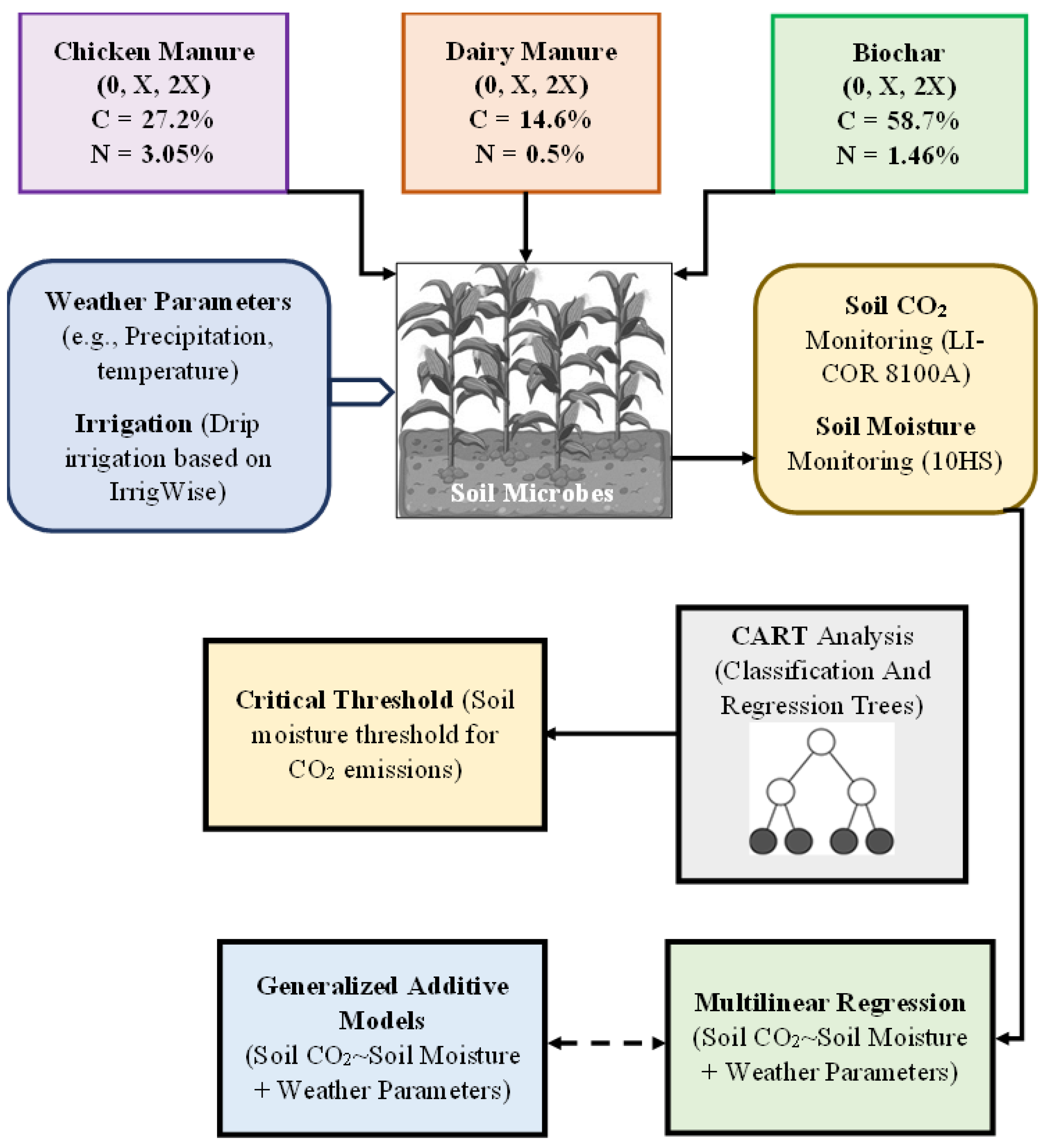

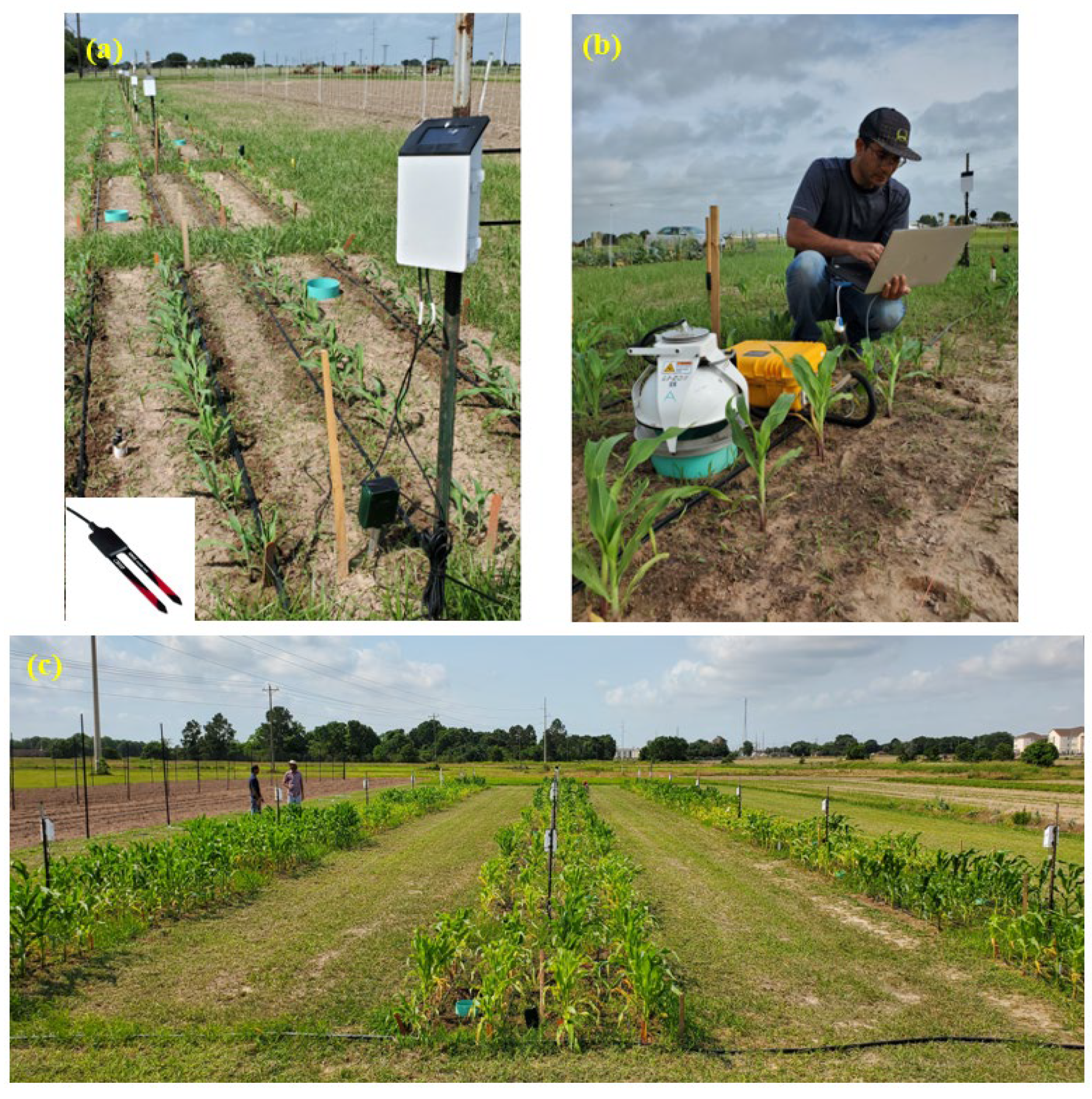


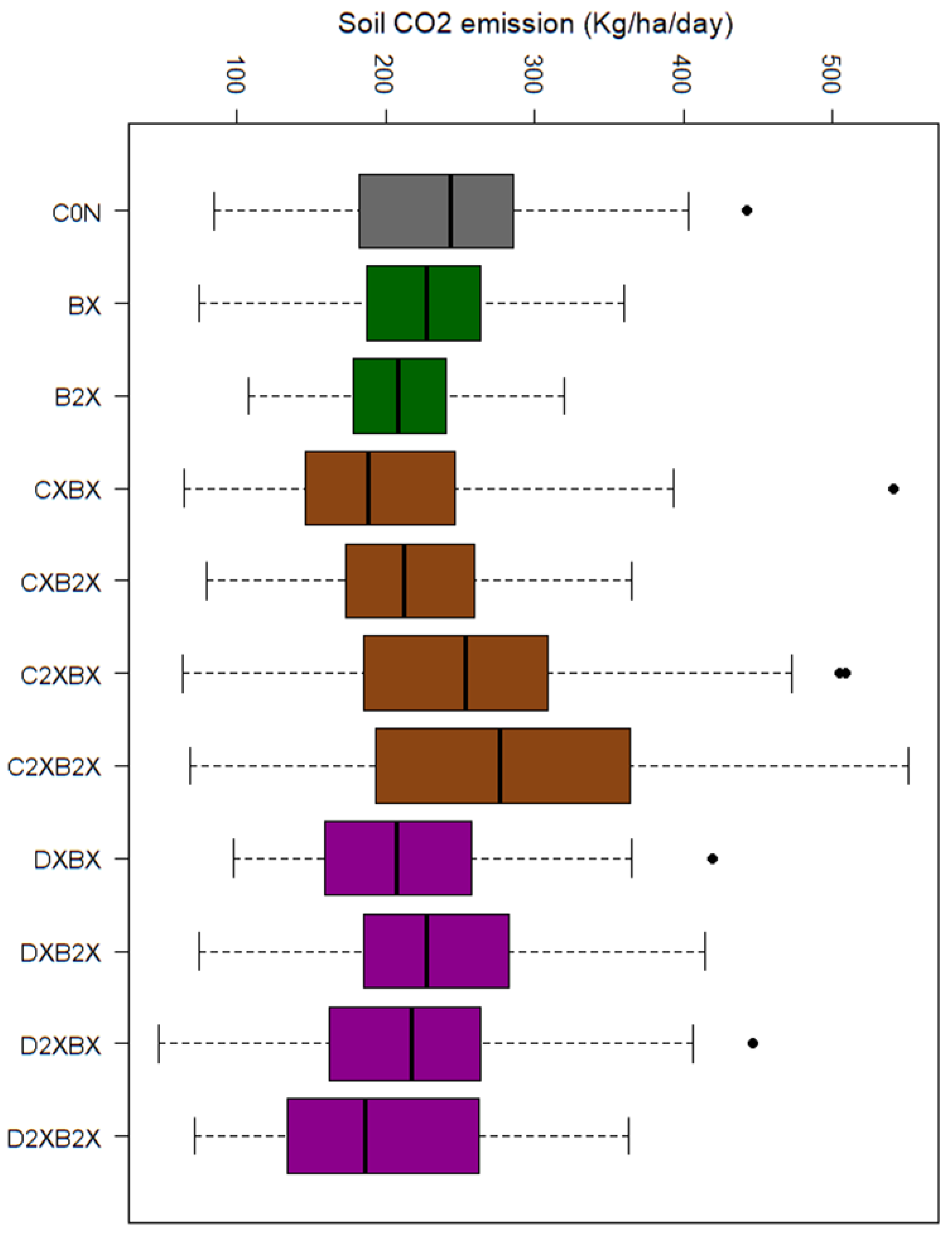
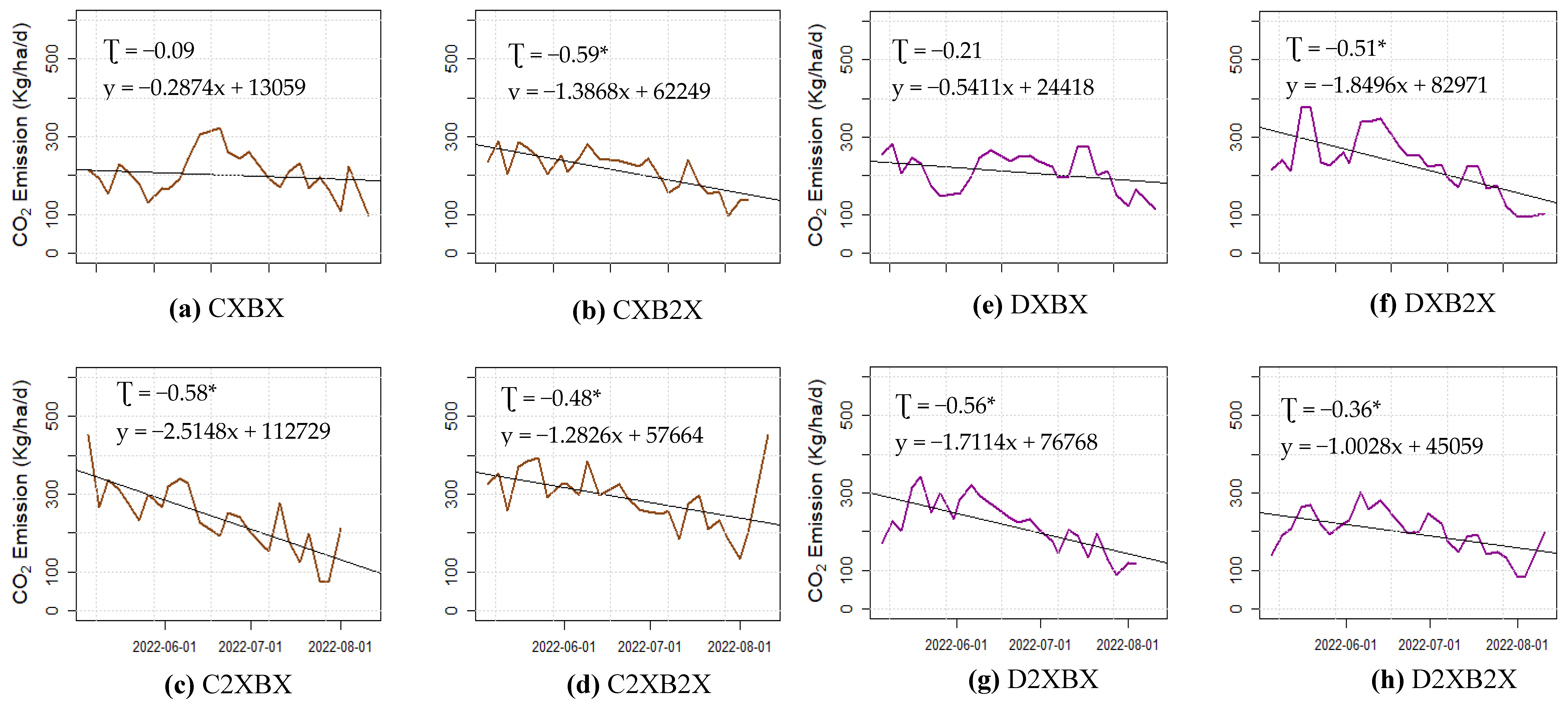

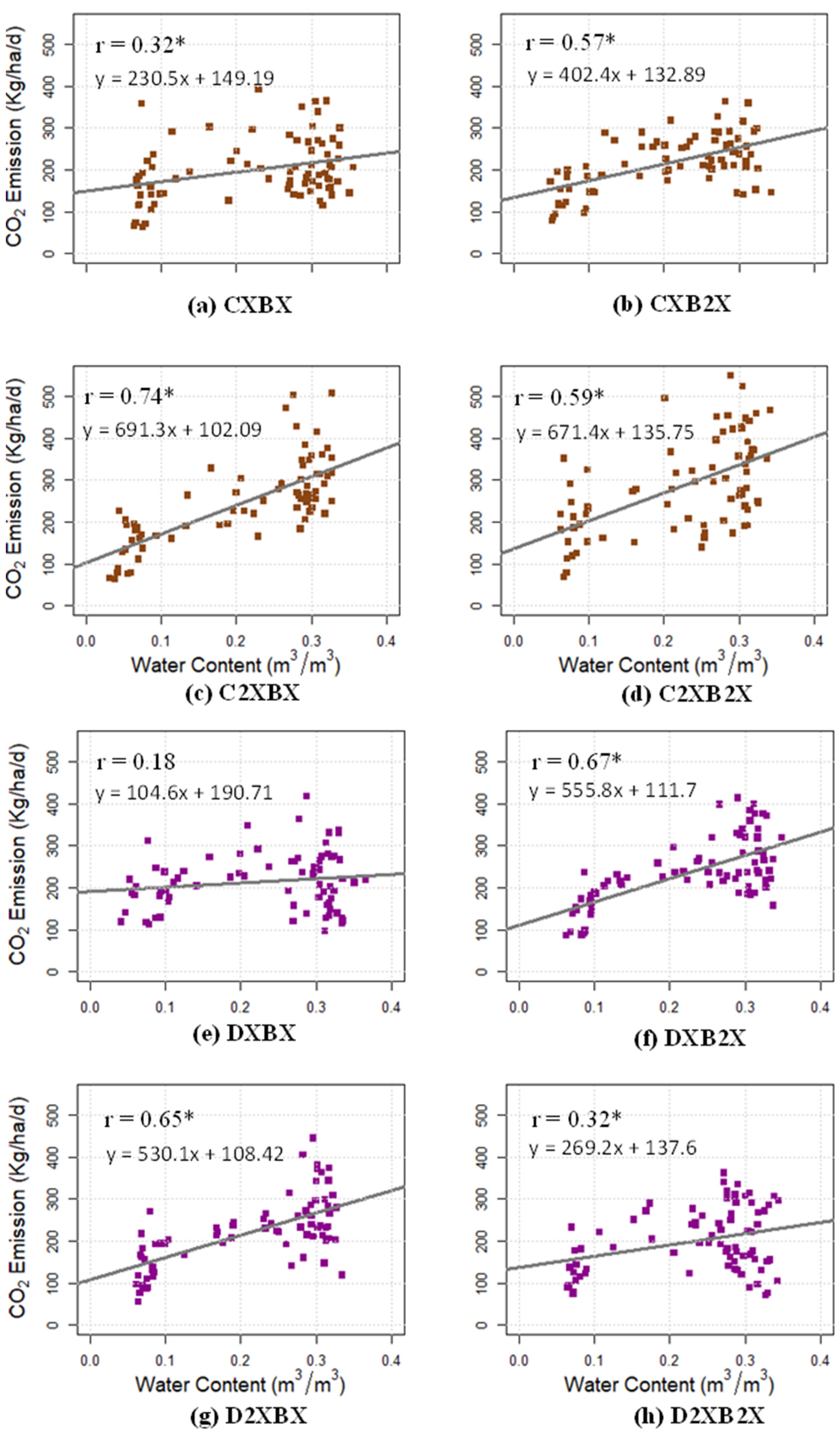
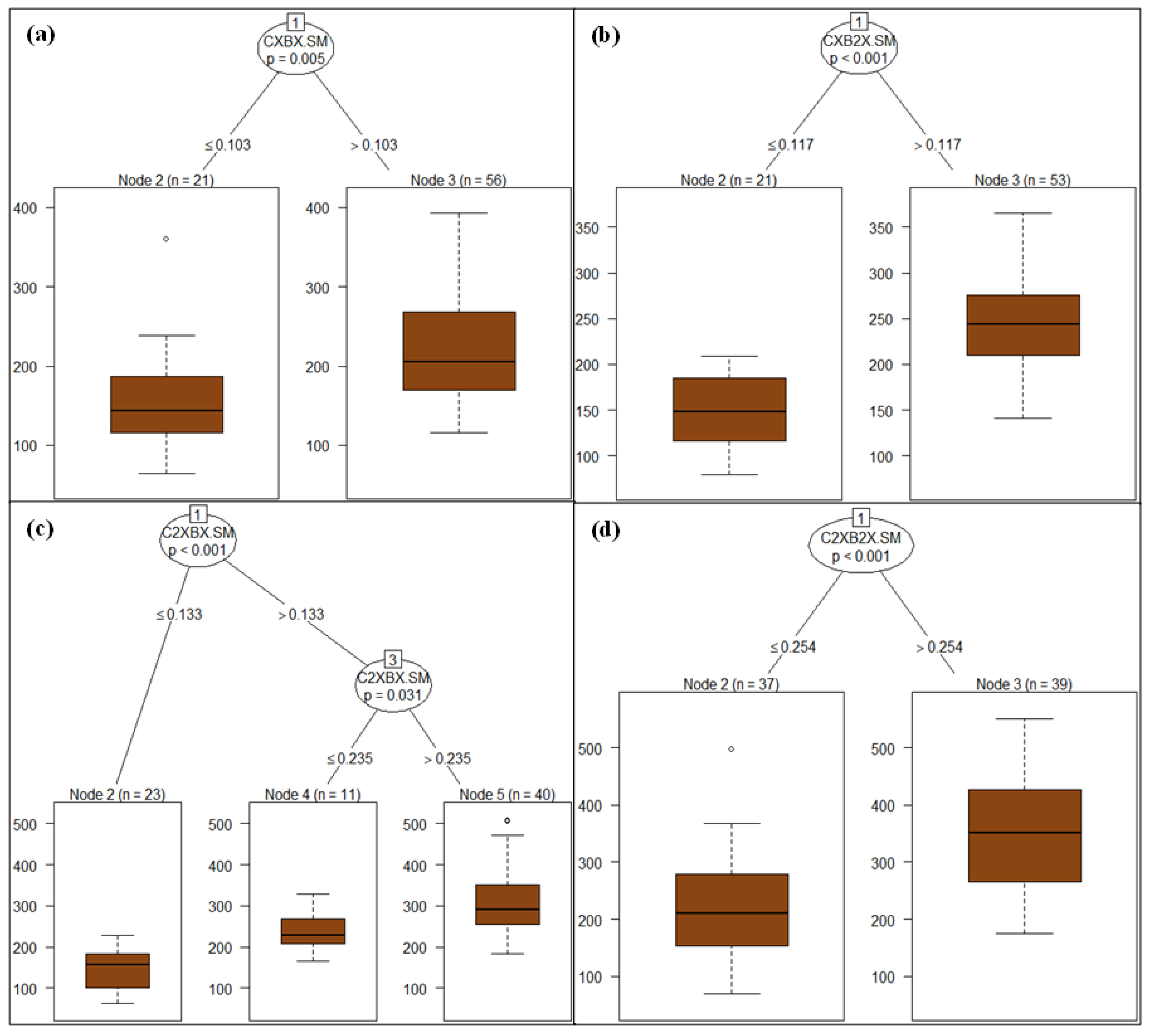
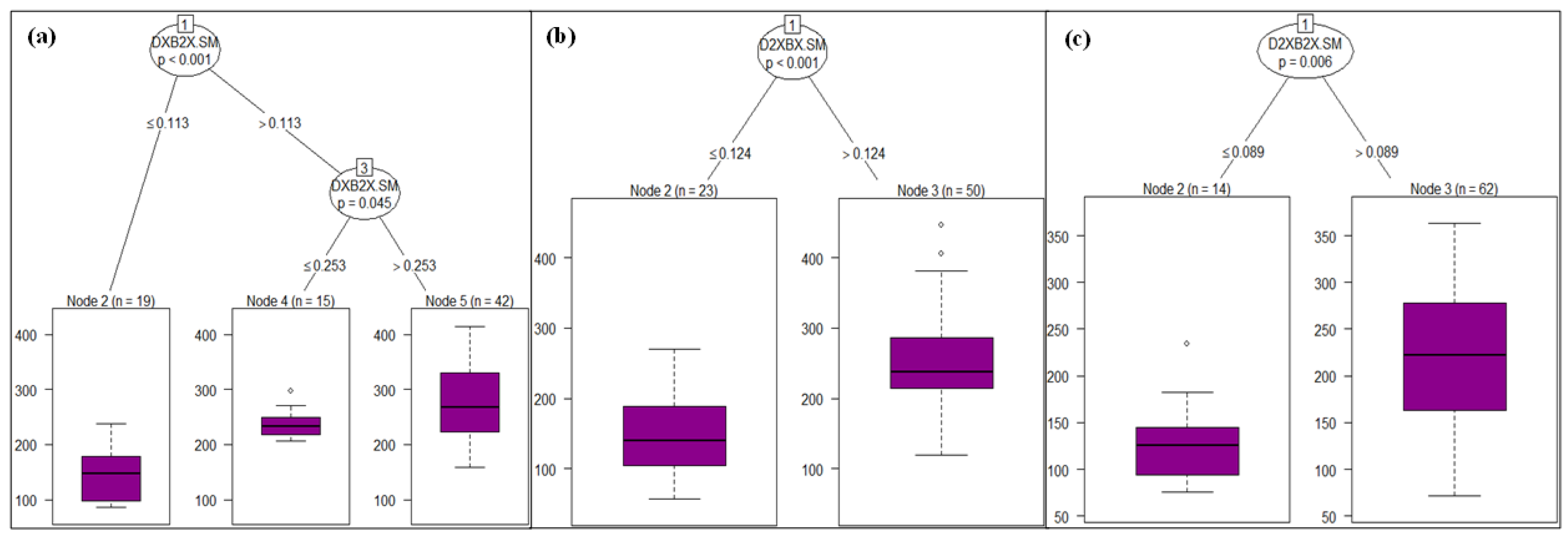
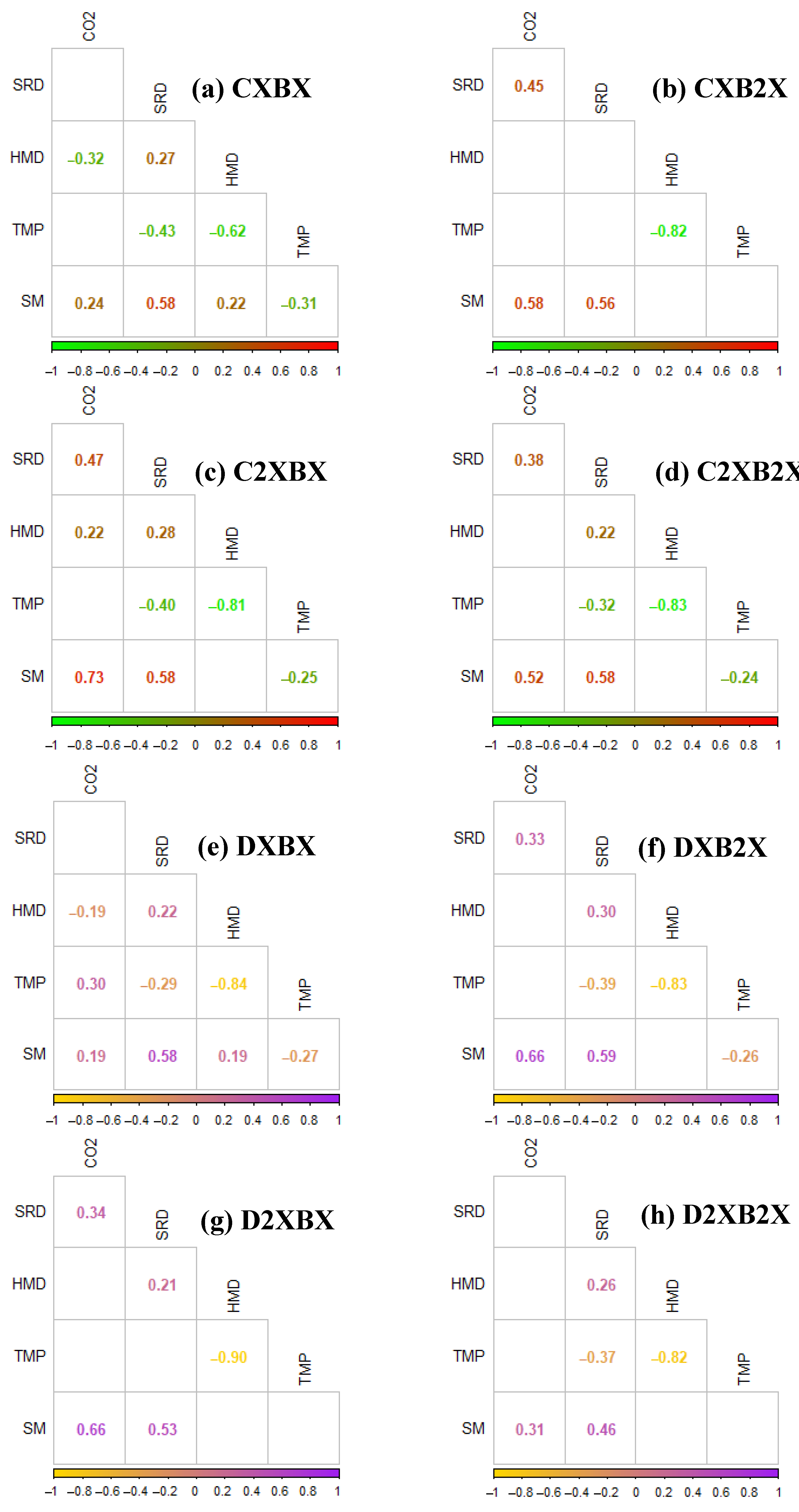
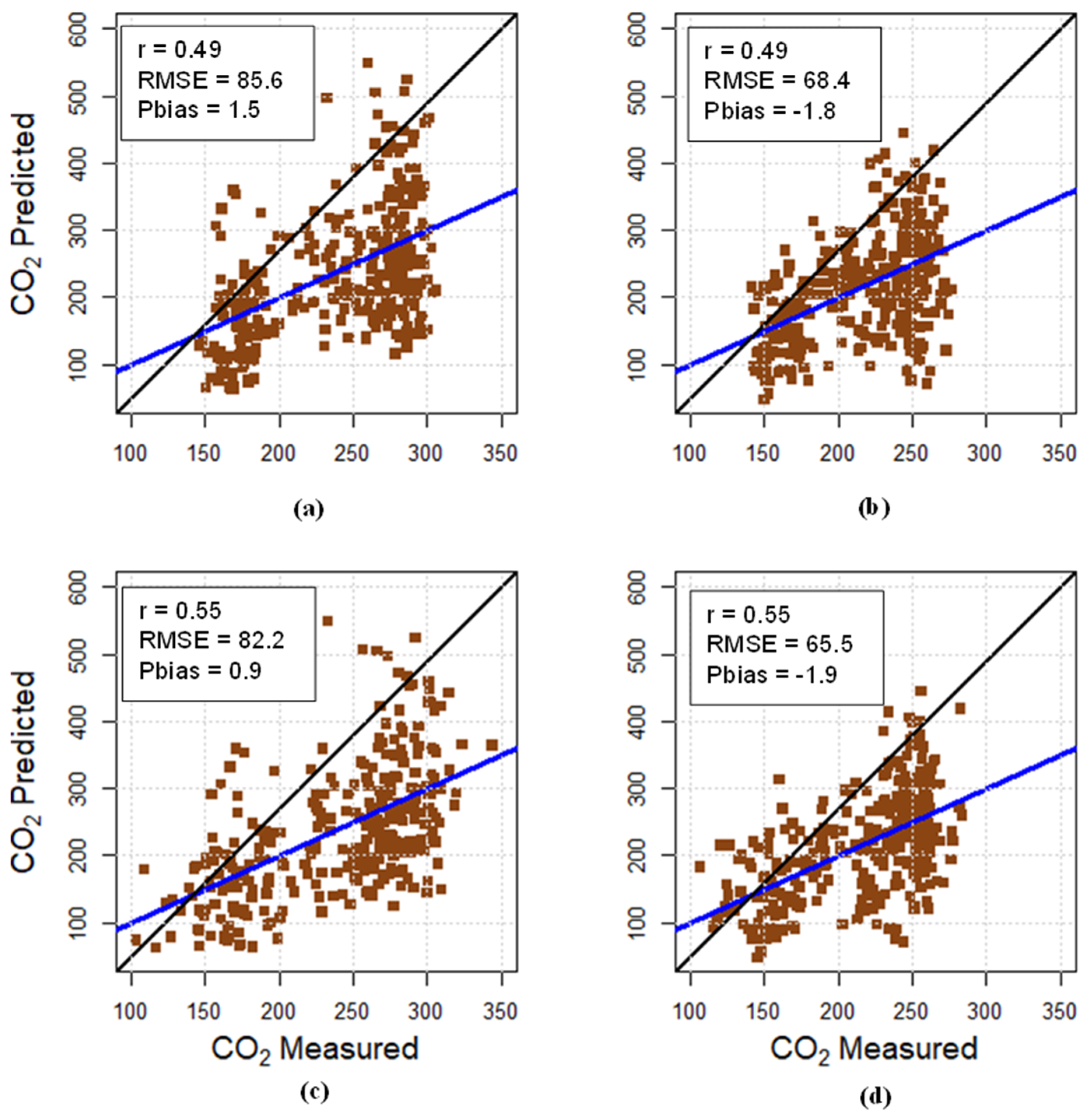
| SOV | D.F. | Significance |
|---|---|---|
| Type | 1 | ** |
| Rate | 2 | ** |
| Biochar | 1 | N.S. |
| Type × Rate | 2 | ** |
| Type × Biochar | 1 | * |
| Rate × Biochar | 2 | ** |
| Type × Rate × Biochar | 2 | * |
| Total | 11 |
Disclaimer/Publisher’s Note: The statements, opinions and data contained in all publications are solely those of the individual author(s) and contributor(s) and not of MDPI and/or the editor(s). MDPI and/or the editor(s) disclaim responsibility for any injury to people or property resulting from any ideas, methods, instructions or products referred to in the content. |
© 2025 by the authors. Licensee MDPI, Basel, Switzerland. This article is an open access article distributed under the terms and conditions of the Creative Commons Attribution (CC BY) license (https://creativecommons.org/licenses/by/4.0/).
Share and Cite
Veettil, A.V.; Rahman, A.; Awal, R.; Fares, A.; Green, T.R.; Thapa, B.; Elhassan, A. Threshold Soil Moisture Levels Influence Soil CO2 Emissions: A Machine Learning Approach to Predict Short-Term Soil CO2 Emissions from Climate-Smart Fields. Sustainability 2025, 17, 6101. https://doi.org/10.3390/su17136101
Veettil AV, Rahman A, Awal R, Fares A, Green TR, Thapa B, Elhassan A. Threshold Soil Moisture Levels Influence Soil CO2 Emissions: A Machine Learning Approach to Predict Short-Term Soil CO2 Emissions from Climate-Smart Fields. Sustainability. 2025; 17(13):6101. https://doi.org/10.3390/su17136101
Chicago/Turabian StyleVeettil, Anoop Valiya, Atikur Rahman, Ripendra Awal, Ali Fares, Timothy R. Green, Binita Thapa, and Almoutaz Elhassan. 2025. "Threshold Soil Moisture Levels Influence Soil CO2 Emissions: A Machine Learning Approach to Predict Short-Term Soil CO2 Emissions from Climate-Smart Fields" Sustainability 17, no. 13: 6101. https://doi.org/10.3390/su17136101
APA StyleVeettil, A. V., Rahman, A., Awal, R., Fares, A., Green, T. R., Thapa, B., & Elhassan, A. (2025). Threshold Soil Moisture Levels Influence Soil CO2 Emissions: A Machine Learning Approach to Predict Short-Term Soil CO2 Emissions from Climate-Smart Fields. Sustainability, 17(13), 6101. https://doi.org/10.3390/su17136101







